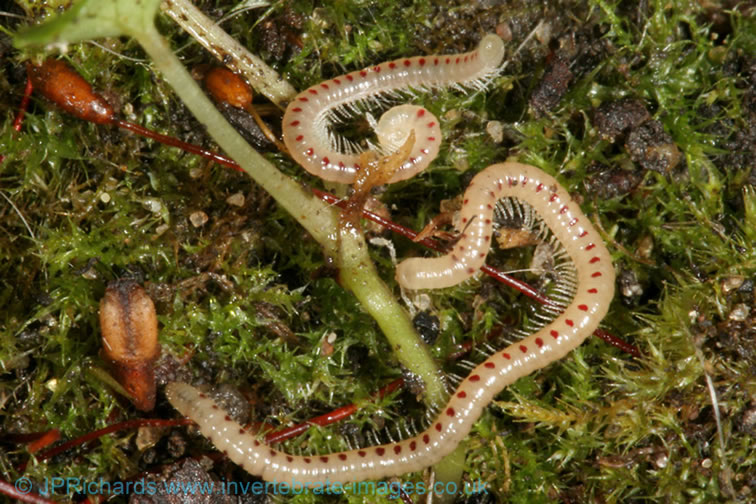Blaniulus guttulatus (Fabricius, 1798)
Status:
GB IUCN status: Least Concern
ID Difficulty
Identification
Blaniulid millipedes are conspicuously long and slender. Live specimens of Blaniulus guttulatus are easily recognisable, being a pale cream colour with contrasting scarlet ozadenes along the sides of the body. It is blind, completely lacking eyes (ommatidia).
Confusion is most likely with the two other blind (i.e. lacking eyes) blanulids Archiboreoiulus pallidus and Boreoiulus tenuis, which both have orange ozadenes. Julid millipedes, such as the blind Cylindroiulus vulnerarius, are much more robust and lack the contrast in body and ozadene colour (most julids have conspicuous eyes).
Distribution
This is a widespread and common species throughout much of Britain and Ireland but is apparently scarce in the extreme north west of Scotland.
In Europe the species is widespread in the Atlantic zone and north central Europe but there are only scattered records further south and east (Kime, 1999) and has been introduced to North America and islands in the Atlantic Ocean (Blower, 1985). It is well known as a pest in agricultural and horticultural systems.
Habitat
Analysis of the recording scheme's habitat data suggests a very strong association with cultivated land and with synanthropic sites including gardens and churchyards. A strong association with waste ground is also suggested. Despite being the most frequent habitat category recorded for this species, the analysis suggests a strong negative relationship with woodland. In contrast Kime (2004) considered it may be a natural component of the woodland fauna on calcareous, loamy soils in Belgium. Although not strong, analysis of the environmental data does provide some support for a link with calcareous loams.
Phenology
Brookes and Willoughby (1978) found that the young millipedes take four years to reach maturity. Adults have been found throughout the year but most frequently in the spring and again in autumn. They are harder to find in winter as falling autumn temperatures cause them to move deeper into the soil until temperatures rise again at the end of winter (Pierrard, Bonte & Baurant, 1963).
This species account is based on Lee (2006).
Links
MilliBase - Global catalogue of Millipedes: https://millibase.org/aphia.php?p=taxdetails&id=945118










